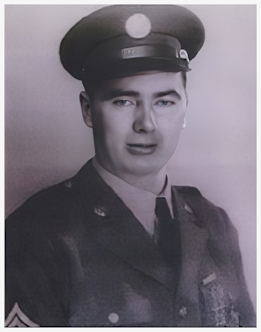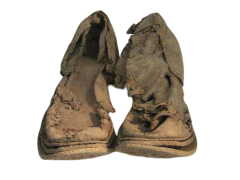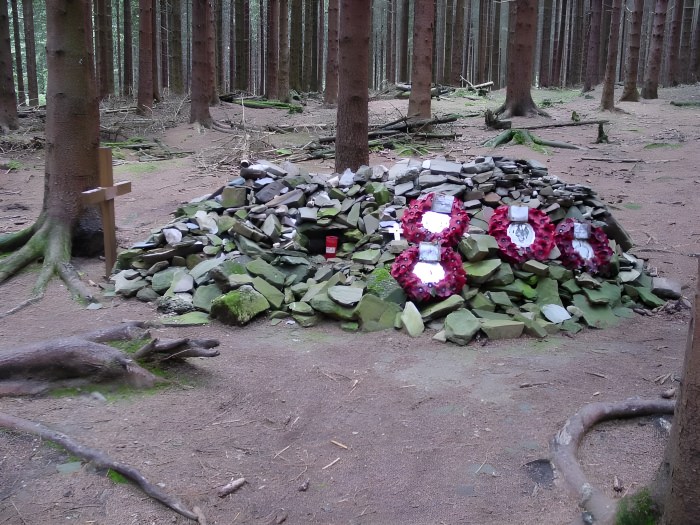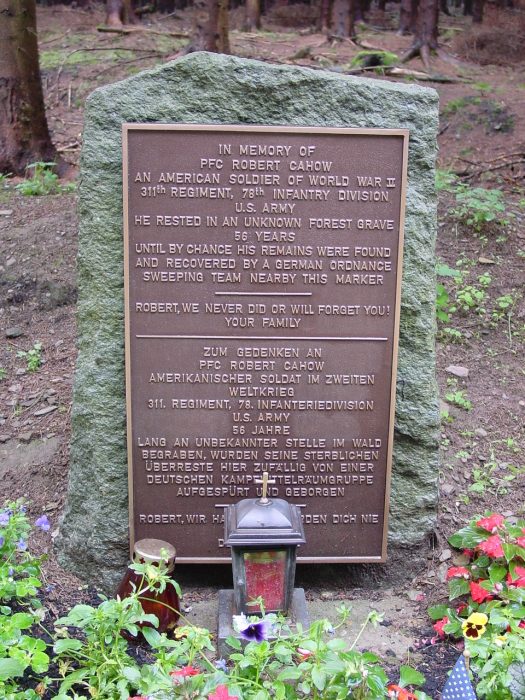
The eldest of 8 brothers from a farming community, Robert Cahow was originally drafted earlier in WW2. He'd been an MP, guarding POW's in America. He volunteered for frontline duty, as he wanted to serve his country in a more active manner. Being 6 foot 7 inches tall Robert stood out from his comrades in the 311th Infantry Regiment, 78th Infantry Division. Cahow and his comrades were soon drawn into the fighting for the Hürtgen forest. The Germans called it "Die Totenfabrik" or Death Factory, with good reason. On December 13th 1944 Company K was assigned to execute a diversionary assault on bunker 111 in the forest. Many of the soldiers in Company K were new to combat. Anti-personnel mines and enemy fire killed and wounded many.
The day was drawing to an end as several survivors of King Company were "volunteered" for the unenviable duty of re-entering the forest in search of wounded from the days assault on the bunker. One of the volunteers was Robert Cahow, the others were Heber Mizell and Wilbur Peddicord.
Harvey Jorgensen, the only man left alive to recount the events recalls;
"The three men, Cahow, Mizell and Peddicord reluctantly trudged into the area of Bunker 111. They were well aware of the dangers, the mines and booby traps, but theirs was a recovery mission. They walked on".
Robert Cahow was a BAR gunner. He had grenades for personal protection as well as his trusty Browning Automatic Rifle, which would be an advantage in laying down a base of fire should the need arise.
Jorgensen continues, "As they ventured further towards the presumed location Bunker 111 there were was an explosion, followed almost at once by a second. There was a cry of great pain and then silence. As to why Mizell and Peddicord left Robert at that time can only be conjecture, but perhaps the thought of more booby traps, or the creeping fear that the Germans were so very near made them retreat at once".
The resulting fire from the alarmed Germans threw the survivors back. The confusion that followed meant that Jorgensen and his comrades couldn't locate Cahow. No one was to know, until his recovery 57 years later that Robert Cahow had been fatally injured by the blast (massive fractures, to his left foot, leg, hip and torso).
Later the Germans found and buried Robert near the bunker that had been his units objective earlier that fateful day. Roberts' younger brother Douglas was just 12. He recalled the day that he and his two young brothers were playing in the barn. They saw a car approaching the farm and hid. They knew what the car meant, they had two elder brothers serving overseas. This car was delivering the message that all families dreaded. Their Father came to tell them the news. As the years rolled by the Cahow family did not forget their eldest son and brother. Their other brother William came home from the war with a leg wound. (He'd been in the 628th Tank Destroyer Battalion and fought right up the May '45).
In April 2000 German engineers were clearing the forest area around Vossenack prior to returning it to farmland. As they did so they began to unearth war debris. Also they found human remains. These were found to be of an American soldier, nearby two German soldiers were also recovered. Below, the helmet of one of the Germans, who had fallen near to Robert.

The Americans ID disks appeared to read Robert Cahow, but research and examination of the disks and the physical size of the remains implied this was a giant of a man, 6 feet 7 inches tall ... Robert had been found.

There were numerous traces of that long past battle in the woods.
Left; Robert Cahows Army boots.
On June 2, 2001, Memorial Day weekend, Cahow was buried with full military honours in his hometown of Clear Lake, Wisconsin, near the dairy farm where he grew up. At least two-thirds of the town’s population of 942 attended the service, as did numerous 78th Division WW II veterans. ‘Taps’ was played by Cahow’s nephew and namesake, Pfc Robert Cahow, Wisconsin National Guard, and his casket was carried to the grave by a contingent of today’s 3rd Battalion, 311th Regiment, 78th Division. Colonel McLean, the division historian, served as the Officer in Charge of the funeral detail.
On June 4, two days after the burial in the States, American and German officials dedicated the memorial in the Hürtgen Forest. The ceremony was attended by Cahow’s brother Douglas and 78th Division veterans. About 50 feet from the granite marker is a big pile of rocks and bits of concrete with a wooden cross marking the place where Cahow was found. The spot is not very far from the memorial marker for the two GIs and one German that were found here in 1976

The actual spot where Cahow was found is marked by a pile of stones and a wooden cross.

The memorial for Robert Cahow in the Hürtgen Forest.

